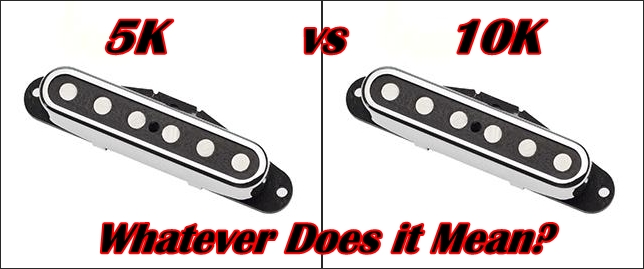Your Cart is Empty
NOW FREE SHIPPING TO 48 CONTIGUOUS UNITED STATES ON ALL ORDERS!!!
How Resistance of a Guitar Pickup Affects Tone and Output.
by vaughn skow March 30, 2018 4 min read
Okay gang, here is part TWO of our discussion on understanding specifications of guitar pickups ... how to turn numbers into an idea of what the TONE will be! The resistance of a guitar pickup is often the most miss-understood spec ... even though it's often the ONE SPEC people think they actually understand! This specification simply tells you how difficult it is for electrons to move from one end of a guitars coil through to the other end. Seriously friends, that's it! Folks read waaaaaay too much into this spec. Let's talk about that! If you're in a hurry, feel free to skip to the bullet-points at the end.

Folks often wrongly think that the resistance spec tells how loud or "hot" a pickup will be; to a certain extent that is true, but ONLY if all other variables are the same. Think of it like this: Let's say we wound a Strat pickup with as much of the typical 42-gauge wire as the bobbin can hold ... that would result in a resistance spec of nearly 8K, very high for a Strat pickup! Now lets say we removed the magnetic pole pieces, the pickup will STILL read 8K, but will produce absolutely no sound at all! Why? Because a magnetic guitar pickup is an ElectroMagnetic Induction device, which turns the motion of your strings in the presence of a magnetic field into current (the sound that comes out the output jack of your guitar). Okay, y'all take a little trip to see how a pickup actually works and then come back to read the rest of this: https://nationalmaglab.org/education/magnet-academy/watch-play/interactive/guitar-pickup.
Okay, hope that little trip helped, did you press the little button to "pluck" the string, cool, huh? I hope you figured out that the overall sound of the pickup is the result of ALL the specs and materials in the pickup ... not just how hard those little electrons need to work to travel around the coil!
So, what DOES the resistance spec tell us? Kinda what you think it does ... when all other variables are exactly the same! For instance, if you take two Strat pickups that have the exact same composition and charge of Alnico magnets in them, are built on exactly the same bobbins, and the coil wire is exactly the same thickness (gauge), and is coated with exactly the same insulating material ... then yes, the resistance spec will tell you how "hot" the pickup will be. That's a LOT of stipulations, but there's more; as in all things audio, this follows a logarithmic scale, it's not linear. So, to wind a "hotter" pickup you don't count 1,2,3... you count 1,100,1000 ...! So a pickup with 10,000 turns of wire is NOT twice as "hot" as one with 5,000 turns ... no, it would take 100,000 to equal that! Ay caramba! But as you wind a pickup hotter, you soon reach the point of diminishing returns, because as you make it harder and harder for electrons to swim through the coil, you begin to have progressively bigger and bigger fish be the only ones burly enough to make the trip. Just like the size of the strings themselves, bigger means lower frequency ... and so the pickup soon goes from being "hotter and hotter" to being more and more muddy!
The HUGE takeaway here is this: Remember that Strat pickup with 5,000 turns (for about a 4k resistance) vs the one with twice the turns and twice the resistance? Well, the one with twice the resistance would be a little louder/hotter ... and a BUNCH less bright! Get it?
So, how about this: we wind that same Strat pickup with 10,000 turns of thinner 44-gauge wire? Can you guess the results? Well, it would clock in at about 15K because it's harder for those electrons to flow through a SMALLER tunnel, and it would be about the SAME output as the one wound with only 5000 turns of 42-gauge wire ... but the tone would be way, way, way darker. Also, if you PHYSICALLY measured the coil, it would be about the same SIZE as the one with 5,000 turns of 42-gauge wire. Yes, in a coil, size matters. Magnetic pickups are governed by the laws of physics. Since the pickups pretty much need to be a given size to match the strings on your guitar, and so our physical minimums and maximums are quite limited. Now if we go for a completely alternative method of turning the motion of the strings into an electric signal, then the physics are totally different, the most common alternative method would be the piezoelectric crystals often used in acoustic guitar pickups, another totally weird and interesting method is the work in photo-electric optical pickups being experimented with: check it out: https://www.youtube.com/watch?v=mISvoHKMl0U ... yep, NYLON strings on a Strat! No need for metal when you are not using magnetic pickups.
Okay, here is the real take away in bullet points:
- The Resistance spec means nothing in itself, only when combined with everything else that comprises a pickup.
- For two Resistance specs to be able to be directly compared, everything else needs to be IDENTICAL.
- As you wind more wire on a coil the resistance goes up.
- Smaller wire will have a higher resistance than an equal amount of larger wire.
- As resistance increases, you soon reach the point where it stops getting louder and it gets DARKER.
- So, resistance tells you NOTHING in and of itself!
There ya have it. Believe it or not we've just scratched the surface of this topic. We never discussed the various coatings on the coil wire or the composition of the wire itself. We also failed to cover the pattern the coil was wound in or how tight it was wound ... and all of these effect the tone and output of a pickup ... irregardless of what the resistance spec says! So what is probably the most IMPORTANT spec then? Well read the next blog in this series to find out! If you have not already, please real the last blog on the value of the magnetic Gauss spec.
Leave a comment
Comments will be approved before showing up.
